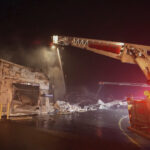It was one of the nation’s deadliest construction crane accidents: A 200-foot-tall rig crashed down on a dense city block, killing seven people, leaving a gash of destruction near the United Nations and raising questions about the safety of the steel spindles that build skyscrapers.
The man prosecutors accuse of causing it, rigging contractor William Rapetti, is poised to go to trial in the March 2008 disaster, which fueled tighter scrutiny of cranes in New York and elsewhere.
Prosecutors say Rapetti recklessly did a slipshod job of securing the rig while it was being extended upward. His lawyer says Rapetti followed common industry practices, and says other factors could have felled the crane. He has suggested some responsibility may lie with a crane operator who was killed in the collapse, infuriating the operator’s family.
Jury selection in the manslaughter case is set to start June 21.
For John Gallego, the trial could mean reliving the roughly four hours he spent trapped in rubble after the crane crushed his apartment building and killed a friend visiting him.
“I try to forget, but honestly, it’s impossible,” said Gallego, 33, a former clothing vendor who walks with a cane after multiple surgeries on his legs. “As soon as I wake up in the morning, and I feel my legs … everything comes to me.
“I just hope they do what they need to do for this not to happen again.”
The 150-ton crane was building a condominium tower, one of many projects relying on similar rigs in the thick of a New York building boom. Some of the East 51st Street project’s neighbors had voiced concerns about the crane swaying or whether it was properly affixed to the tower. But it passed multiple inspections, including one on March 14, 2008.
The next day, as the crane was being lengthened, it tore away from the building and toppled like a tree, scattering pieces as far as a block away.
Six construction workers and Gallego’s friend were killed; two dozen others were hurt. Gallego’s four-story building was demolished, and several others in the midtown residential neighborhood were damaged.
Prosecutors, city building officials and the Occupational Safety and Health Administration pegged the collapse on the failure of four polyester straps that Rapetti and his crew used to hold up a 6-ton steel collar, helping to connect the crane to the building’s 18 stories.
Rapetti used four straps when the crane’s manufacturer called for eight, didn’t take precautions to keep them from fraying as they were pulled against the crane’s metal edges, and used a strap that was badly worn, prosecutors said.
The straps snapped, and the collar plummeted into other collar assemblies farther down the crane, breaking a crucial anchor to the building, the investigations found.
“There was no doubt that (Rapetti) created a situation rife with the reasonably foreseeable risk of death,” Manhattan Assistant District Attorney Sean Sullivan wrote in court papers.
Rapetti’s lawyer, Arthur Aidala, said the rigger was scrupulously careful about a job that put him in danger himself. Rapetti was standing on a beam that was about to be connected to the 18th-floor collar when the crane fell; he dove to safety in the building but was seriously hurt, Aidala said.
Rapetti followed common industry procedures, which diverged from manufacturers’ guidelines, Aidala said. He also is challenging the findings that the straps failed and caused the crash.
“It’s our position that nobody knows why the crane went down,” Aidala said Friday. He said he may present multiple potential explanations for the disaster, including an argument that crane operator Wayne Bleidner moved the rig in a way that destabilized it.
A lawyer for the veteran crane operator’s widow, Denise, called that suggestion a desperate and offensive tactic.
“Instead of Rapetti stepping up and taking responsibility for what multiple agencies and multiple independent parties have determined to be his fault, he now, in the most cowardly way, is going to blame the victim,” said the lawyer, Howard S. Hershenhorn. Denise Bleidner is suing Rapetti’s company and others, as is Gallego.
While about 60 to 80 people die in crane-related incidents nationwide in an average year, according to OSHA figures, the March 2008 collapse _ and a second New York crane collapse that killed two people two months later _ spurred concern about cranes far beyond the city. Dallas officials promptly checked the 23 cranes working there after the March accident and found more than one-third had uncertified operators.
In New York, the fallout included the resignation of the city’s top building official, criminal charges against a city inspector accused of lying about having examined the crane 11 days before it fell, and a roster of new crane safety efforts.
They include hiring more inspectors, expanding training requirements and inspection checklists and banning the use of nylon straps unless a crane manufacturer recommends them. City Buildings Department spokesman Tony Sclafani said the city is planning more improvements, including finding ways to keep track of cranes’ history as they move around the country.
As a start, Chicago, New York and Philadelphia officials began sharing information last year on some of the cranes at work in their cities.
Topics New York
Was this article valuable?
Here are more articles you may enjoy.


 Progressive Insurance Is Hiring Again; 12,000 More People Needed
Progressive Insurance Is Hiring Again; 12,000 More People Needed  New Jersey Wildfire 75% Contained; Crews to Remain on Scene Until ‘Significant’ Rain
New Jersey Wildfire 75% Contained; Crews to Remain on Scene Until ‘Significant’ Rain  Florida Class Action Targets Litigation Funding Firm Over Data Breach
Florida Class Action Targets Litigation Funding Firm Over Data Breach  Class Action Accuses Toyota of Illegally Sharing Drivers’ Data With Progressive
Class Action Accuses Toyota of Illegally Sharing Drivers’ Data With Progressive 

